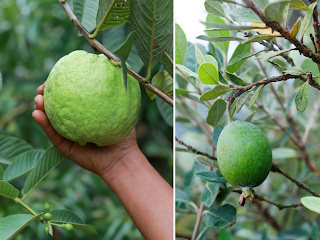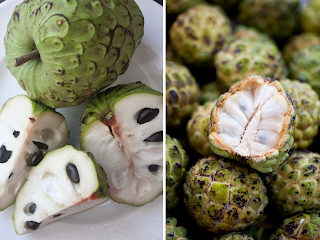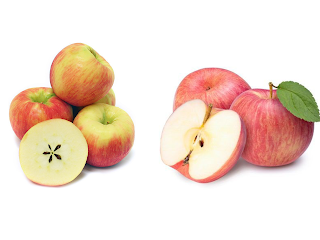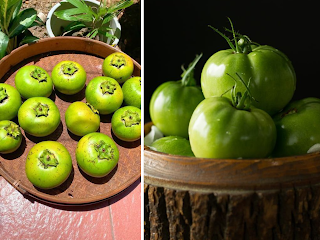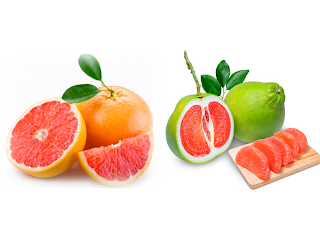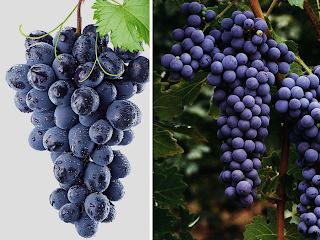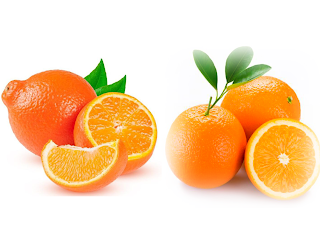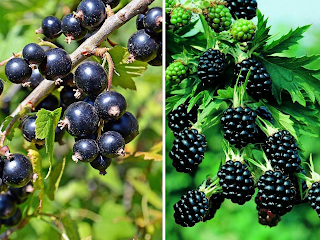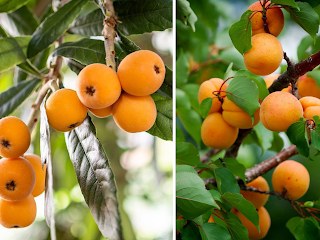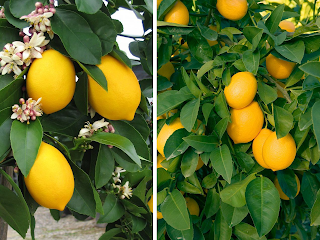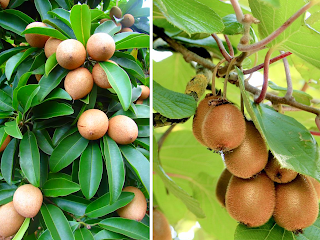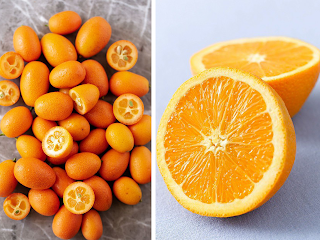Fruits that look similar but have distinctly different tastes offer a fascinating insight into the diversity of nature's bounty. Here's a list of top 10 pairs of fruits that might look alike at first glance but differ significantly in taste:
1. Guava vs. Feijoa:
Guava and feijoa are both tropical fruits with distinct characteristics. Guava comes in various shapes and sizes, depending on the variety. It can be round, oval, or pear-shaped with smooth green or yellow skin that may turn slightly pink or red when ripe.
The flesh inside a guava is white, pink, or yellow, with a sweet, sometimes musky flavor and small, edible seeds. Guavas are enjoyed fresh, sliced and eaten with a sprinkle of sugar or salt, or used in jams, jellies, and juices.
Feijoa, also known as pineapple guava, is an oval-shaped fruit with a greenish-yellow skin and a bumpy, uneven texture. When ripe, the skin yields to gentle pressure. Unlike guava, the feijoa skin is not typically eaten.
The flesh inside is creamy white to yellow, with a sweet, tropical flavor reminiscent of pineapple and guava. Feijoas are enjoyed fresh, scooped out and eaten like a kiwi, or used in jams, chutneys, or salsas.
2. Persimmon vs. Tomato:
Persimmons and tomatoes might seem like an unusual comparison, but they are both fruits despite being used in different ways. Persimmon is a brightly colored fruit that comes in various shapes and sizes depending on the variety. Some persimmons are round and pumpkin-like with deep orange skin, while others are squat and tomato-shaped with a vibrant orange or deep red color.
Unlike tomatoes, persimmons have a non-acidic taste. Depending on the variety, they can be astringent when unripe but become sweet and luscious when fully ripe. Persimmons are enjoyed fresh, dried, or used in puddings and baked goods.
Tomatoes, on the other hand, are a versatile fruit commonly treated as a vegetable in culinary applications. They come in various shapes and sizes, ranging from small cherry tomatoes to large beefsteak varieties.
Tomatoes have a wide range of flavors, from sweet to slightly tart, depending on the variety. They are a staple ingredient in many savory dishes, salads, and sauces. While some tomato varieties are eaten raw, others are best enjoyed cooked or juiced.
3. Plantain vs. Banana:
Plantains and bananas, though similar in appearance, have distinct characteristics. Plantains are larger and sturdier than bananas, with thicker skin that's green, yellow, or even black when ripe. Unlike bananas, which are eaten solely when ripe and sweet, plantains can be enjoyed at various stages. Unripe plantains boast a high starch content and neutral flavor, making them ideal for savory dishes like fritters or chips. As they ripen, the starches convert to sugars, offering a hint of sweetness that complements both sweet and savory applications.
Plantains are a staple in many cultures, particularly across the Caribbean, Latin America, and Africa, where they're featured in various culinary creations.
4. Cherimoya vs. Custard Apple (Sweetsop):
Cherimoya and custard apple are exotic fruits with unique appearances and flavors. Cherimoya, also known as "custard apple heart," has a heart-shaped exterior covered in green, scaly bumps. Its creamy white flesh boasts a sweet, custard-like flavor with hints of citrus and pineapple.The black, inedible seeds are scattered throughout the flesh. Custard apple, on the other hand, has a bumpy, lumpy brown or green exterior. Its interior flesh is also creamy white but possesses a custard-like flavor with a strong undertone of banana and tropical fruits.
Both fruits are enjoyed ripe when the exterior yields to gentle pressure. Their unique flavors make them perfect for eating fresh or incorporating into desserts and smoothies.
5. Honeycrisp Apple vs. Fuji Apple:
Honeycrisp and Fuji apples are popular dessert apple varieties offering distinct taste and texture experiences. Honeycrisp apples are known for their incredibly crisp and juicy flesh. They have a balanced sweet-tart flavor with a hint of honey. The skin is thin and yellow-green with a reddish blush. Honeycrisp apples are best enjoyed fresh due to their tendency to brown quickly. Fuji apples, conversely, have a slightly softer, more yielding texture with a balanced sweet and tangy flavor.
Their skin is thicker and red or yellow-red with a slight waxy sheen. Fuji apples are known for their excellent storage capabilities, making them a versatile choice for both fresh eating and baking.
6. Black Sapote vs. Green Tomato:
These two round fruits might look similar at first glance, but they have distinct characteristics. Green tomatoes are unripe versions of the familiar red tomato, a nightshade vegetable. They are firm, sour, and inedible when raw. Green tomatoes are typically used in salsas, pickles, or fried green tomato dishes once cooked.Black sapote, on the other hand, is a tropical fruit native to Mexico and Central America. While the unripe fruit has green skin like a tomato, when ripe, its skin darkens and the inside becomes a rich, dark brown or black, earning it the nickname "chocolate pudding fruit."
Unlike green tomatoes, black sapote flesh is soft, sweet, and eaten ripe, often scooped out and enjoyed on its own or used in desserts due to its unique chocolatey flavor.
7. Grapefruit vs. Pomelo:
Both grapefruit and pomelo are citrus fruits, but pomelo is considered the granddaddy of the grapefruit. Grapefruits are a hybrid between pomelo and sweet orange, resulting in a smaller, juicy fruit with a tangy, sometimes bitter flavor. They are easily peeled and sectioned for eating or juicing.Pomelo, on the other hand, is much larger than a grapefruit, with a thicker rind that can be challenging to peel. The flesh inside is pale yellow or pink and has a milder, sweeter flavor compared to grapefruit. Pomelo is typically eaten fresh, with the segments separated from the thick rind and membranes.
8. Dark Grapes vs. Blueberries:
While both dark grapes and blueberries are small fruits rich in antioxidants, they belong to different plant families. Dark grapes, like Concord or Cabernet Sauvignon, are a type of vine fruit. They have a deep purple to black skin and a sweet, slightly tart flavor. Dark grapes are enjoyed fresh, dried as raisins, or used in wine production.
Blueberries are a type of low-growing shrub berry. They are a beautiful blue color with a sweet, slightly acidic taste. Blueberries are eaten fresh, frozen, or used in jams, pies, and other baked goods. They are also prized for their high nutritional value.
9. Jujube vs. Plum:
Jujube and plum are both stone fruits, meaning they have a single pit in the center surrounded by fleshy fruit. However, they come from different plant families. Jujube, also known as Chinese date, is a member of the buckthorn family.
It is an oval-shaped fruit with a thin, brown skin and a sweet, chewy flesh. Jujube can be eaten fresh, dried, or used in candies and teas.
Plums come in various shapes and sizes, but typically have a round or oval shape with a smooth, edible skin. They can be red, purple, yellow, or green depending on the variety. Plums have a sweet or tart flavor and are enjoyed fresh, dried as prunes, or used in jams, jellies, and other dishes. .
10. Tangelo vs. Orange:
Tangelo is a citrus fruit that is a hybrid between a tangerine and a grapefruit. It has a tangerine-like appearance with a bumpy, orange rind. The flesh inside is juicy and sweet, with a slightly tangy flavor that's milder than a grapefruit. Tangelos are typically eaten fresh, peeled, and sectioned.
Oranges are a classic citrus fruit with a bright orange rind and juicy, segmented flesh. They come in various varieties, with some having a sweeter taste and thinner skin, while others are known for their tangy flavor and thicker rind. Oranges are enjoyed fresh, juiced, or used in marmalades, desserts, and savory dishes.
11. Black Currant vs. Blackberry:
These dark colored berries share some similarities but have distinct characteristics. Black currants are small, deep purple to black fruits that grow in clusters on a shrub.
They have a tart, almost pungent flavor and are rarely eaten raw. Black currants are most commonly used in jams, jellies, syrups, and liquors due to their intense flavor and high concentration of vitamin C.
Blackberries, on the other hand, are a type of bramble fruit that grows in clusters on long, thorny vines. They come in various colors, including black, red, and purple, and have a sweet, juicy flavor when ripe.
Blackberries are delicious eaten fresh, used in pies, jams, and crumbles, or enjoyed dried.
12. Loquat vs. Apricot:
Loquat and apricot are both stone fruits with a single pit in their center. However, they have some key differences. Loquats are an evergreen tree native to China, with small, oblong fruits.
Their skin is thin, yellow or orange when ripe, with a fuzzy texture similar to a peach. The flesh inside is white, juicy, and has a sweet-tart flavor. Loquats are typically eaten fresh, peeled, and the pit removed.
Apricots are a deciduous tree native to Central Asia, with slightly larger fruits than loquats. They are round or oval-shaped with a smooth, orange skin that becomes slightly wrinkled when ripe.
Apricot flesh is orange, sweet, and slightly tart. They are enjoyed fresh, dried as dried apricots, or used in jams, pies, and savory dishes.
13. Meyer Lemon vs. Regular Lemon:
Meyer lemons are a hybrid citrus fruit between a regular lemon and either a mandarin orange or a Seville orange. They are smaller than regular lemons with a thinner, smoother, and sometimes yellow-tinged rind.
Meyer lemons have a milder flavor than regular lemons, with a touch of sweetness that makes them popular for eating fresh. Their juice is also used in cooking and baking.
Regular lemons are the classic citrus fruit with a bright yellow rind and a thick, bumpy texture. They are known for their tart, acidic flavor and are a staple ingredient in many savory dishes.
14. Nance vs. Cherry:
Nance and cherry are both small, round fruits, but they come from entirely different plant families. Nance is a tropical fruit native to Central and South America.
It has a yellow or orange rind that encases a white, fleshy pulp surrounding a large pit. Nance flesh has a sweet-tart flavor and is often used in beverages, jams, and desserts.
Cherries are a type of drupe fruit that grows on trees in temperate climates. They come in various sweet and tart varieties, with colors ranging from red to black. Cherries are enjoyed fresh, dried, frozen, canned, or used in pies, jams, and juices.
15. Sapodilla vs. Kiwi:
Sapodilla and kiwi are both tropical fruits with unique appearances and flavors. Sapodilla, also known as naseberry, is a brown, oval-shaped fruit with a rough, bumpy skin.
Inside, the flesh is black and has a grainy texture similar to a pear. Sapodilla has a sweet, slightly milky flavor and is enjoyed fresh, scooped out and eaten like pudding.
Kiwi, on the other hand, is an oval-shaped fruit with fuzzy brown skin and green or yellow flesh studded with tiny black seeds. Kiwis have a tangy, sweet-tart flavor and are typically eaten fresh, peeled, and sliced..
16. Kumquat vs. Orange:
Kumquats and oranges are both citrus fruits, but kumquats are known for their unique edible rind. Kumquats are small, oval-shaped fruits with a bright orange rind that is thin and sweet.
The flesh inside is juicy and tart, with a flavor similar to a mandarin orange. Kumquats are typically eaten whole, with the rind adding a delightful sweetness to the tart flesh.
Oranges, as mentioned earlier, are a classic citrus fruit with a bright orange rind and juicy, segmented flesh. They come in various varieties, with some having a sweeter taste and thinner skin, while others are known for their tangy flavor and thicker rind.
Unlike kumquats, orange rinds are not typically eaten due to their bitterness.
NOTE : "Information provided by Gemini, a large language model from Google AI."
